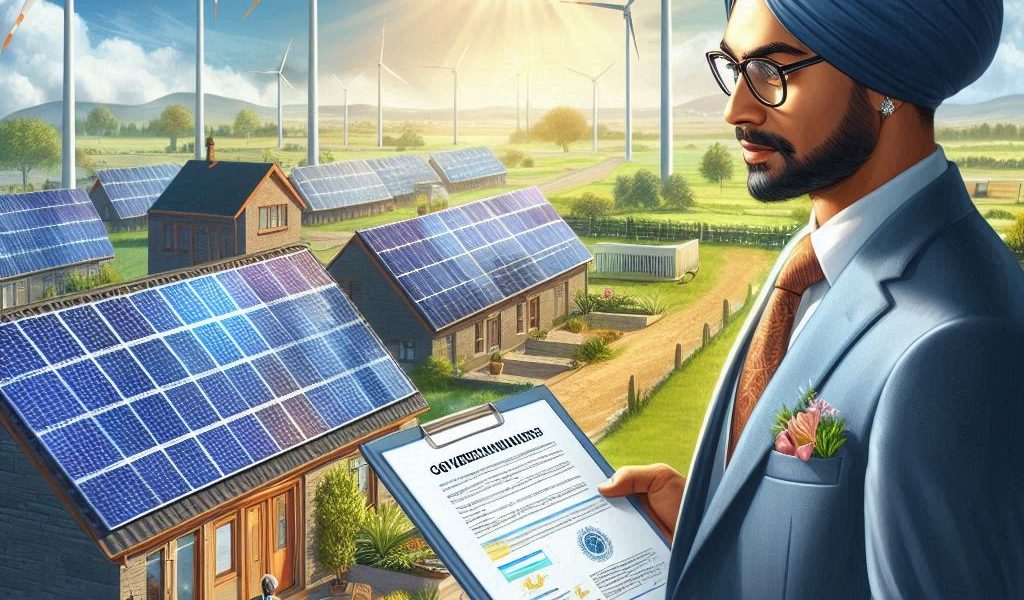As the world shifts towards sustainability and eco-friendly practices, the demand for clean and renewable energy sources like solar, wind, and hydroelectric power has significantly increased. India, as part of its commitment to reducing carbon emissions and promoting green energy solutions, offers various government incentives, grants, and subsidies to encourage the adoption of solar and renewable energy technologies. These financial aids are designed to help businesses, homeowners, and communities transition to renewable energy solutions, making clean energy more accessible and affordable.
If you’re considering installing solar panels, wind turbines, or other renewable energy systems, you may be eligible for government grants and subsidies that can reduce your upfront costs. In this blog, we’ll discuss the different types of green energy grants available, how to apply for them, and the benefits of switching to renewable energy.
Why Switch to Green Energy?
Before diving into the various government incentives available for solar and renewable energy, let’s briefly explore the reasons why you should consider switching to green energy:
- Environmental Benefits: Renewable energy sources like solar and wind power produce little to no pollution, making them environmentally friendly alternatives to fossil fuels.
- Cost Savings: While the initial investment for solar panels or wind turbines may seem high, the long-term savings on electricity bills can be substantial.
- Energy Independence: By generating your own energy through solar or wind, you can reduce dependence on external sources, contributing to national energy security.
- Job Creation: The renewable energy sector is booming and has created a significant number of jobs in manufacturing, installation, and maintenance.
- Government Support: Governments worldwide, including India, are providing incentives and grants to make renewable energy solutions more affordable and accessible to individuals and businesses.
Types of Green Energy Grants and Incentives in India
The Indian government provides several schemes, grants, and financial incentives to promote the use of renewable energy technologies, especially solar energy. Here are some of the key programs available to you:
1. Solar Rooftop Scheme
The Ministry of New and Renewable Energy (MNRE) offers a Solar Rooftop Scheme that provides subsidies for installing rooftop solar systems on residential, commercial, and institutional buildings. This scheme is aimed at promoting the installation of solar panels in urban and semi-urban areas.
Key Features of the Solar Rooftop Scheme:
- Subsidy Amount: Homeowners and businesses can receive a subsidy of up to 40% on the cost of installing solar panels (up to 3 kW) for residential areas and 20% for commercial buildings.
- Eligibility: The scheme is available to individuals, housing societies, and institutions looking to install rooftop solar systems.
- Objective: To reduce dependency on grid power, lower electricity bills, and promote the use of clean, renewable energy.
- Application Process: You can apply through the Solar Rooftop Portal on the official MNRE website or approach a registered channel partner.
2. Kisan Urja Suraksha Evam Utthaan Mahabhiyan (KUSUM) Scheme
The KUSUM Scheme is designed to promote solar energy generation in rural areas, particularly for farmers. Under this scheme, the government encourages farmers to install solar-powered pumps for irrigation, providing subsidies to reduce the financial burden.
Key Features of the KUSUM Scheme:
- Subsidy Amount: Up to 60% subsidy for installing solar water pumps and up to 30% for setting up solar power plants.
- Eligibility: Farmers and agricultural institutions can apply for this scheme.
- Objective: To reduce the dependency on conventional fuel-powered pumps and promote sustainable farming practices.
- Application Process: Farmers can apply for subsidies through state governments and renewable energy agencies.
3. National Bioenergy Programme
The National Bioenergy Programme focuses on promoting the use of bioenergy through biogas, biomass, and waste-to-energy technologies. This scheme supports both rural and urban areas in the use of bioenergy solutions for cooking, heating, and power generation.
Key Features of the National Bioenergy Programme:
- Subsidy Amount: The government offers financial assistance for the installation of biogas plants and bioenergy systems.
- Eligibility: Individuals, institutions, and businesses can apply for this scheme.
- Objective: To promote clean cooking solutions, reduce emissions, and use organic waste for energy generation.
- Application Process: Applications are processed through the Ministry of New and Renewable Energy (MNRE) and state-level agencies.
4. State-Level Solar Incentives
In addition to central government schemes, various states in India also offer their own subsidies, incentives, and grants for adopting solar and renewable energy systems. These incentives vary from state to state and can significantly reduce the upfront costs of solar installations.
Examples of State-Level Incentives:
- Maharashtra: Offers 30% subsidies for residential solar rooftop installations.
- Tamil Nadu: Provides up to 50% subsidy for rooftop solar systems for residential and commercial buildings.
- Delhi: Offers incentives for solar installations, including financial assistance for rooftop solar panels.
Objective: To promote clean energy at the state level and encourage wider adoption of renewable energy technologies.
5. Solar Power Purchase Agreements (PPA)
Under the Solar Power Purchase Agreement (PPA) model, businesses and homeowners can enter into agreements with solar energy companies to purchase electricity generated by solar panels. These agreements typically come with government incentives, making it more affordable for users to switch to solar power.
Key Features of PPA:
- Subsidy Amount: Reduced cost of electricity and attractive financing options for solar installations.
- Eligibility: Available for businesses, government institutions, and residential areas.
- Objective: To encourage renewable energy use by providing low-cost power through long-term agreements.
6. Wind Energy Grants and Incentives
Wind energy is another renewable resource that is gaining traction in India. The government provides grants and financial support for setting up wind energy farms, as well as for individual installations in areas with high wind potential.
Key Features of Wind Energy Grants:
- Subsidy Amount: Financial assistance for setting up wind energy systems, including wind turbines.
- Eligibility: Available for businesses and communities in wind-prone areas.
- Objective: To promote the adoption of wind energy for both power generation and as an alternative energy source.
- Application Process: Applications can be made through the Ministry of New and Renewable Energy (MNRE) or state energy departments.
How to Apply for Green Energy Grants?
Applying for green energy grants requires careful preparation and adherence to the respective application processes. Here are the general steps to apply for government subsidies for solar and renewable energy systems:
Step 1: Assess Your Eligibility
Before applying for any green energy grant, make sure you meet the eligibility criteria of the scheme. Some grants are only available to specific sectors (e.g., farmers, businesses, or residential buildings), while others may require you to meet certain technical requirements.
Step 2: Install a Registered Solar or Renewable Energy System
To qualify for government incentives, your solar or renewable energy system must be installed by a registered vendor or contractor. Ensure that your installation complies with the guidelines set by the MNRE or relevant state authorities.
Step 3: Prepare Required Documents
Gather the necessary documentation, which may include:
- Proof of identity and address
- Business registration (if applicable)
- Bank details for subsidy disbursement
- Details of the solar or renewable energy system installation
Step 4: Submit the Application
Submit your application for the subsidy through the relevant portal or at your local renewable energy office. Some schemes may require you to apply through an online portal, while others may require offline submissions.
Step 5: Wait for Approval and Funding
Once you submit your application, it will be processed, and after approval, the subsidy amount will be disbursed directly to your bank account or vendor.
Benefits of Green Energy Grants
- Cost Reduction: Government subsidies significantly lower the initial installation cost, making solar and renewable energy more affordable.
- Sustainability: By transitioning to renewable energy, you reduce your carbon footprint and contribute to environmental sustainability.
- Energy Security: Renewable energy systems provide energy independence, ensuring consistent power supply and reducing reliance on traditional energy sources.
- Government Support: The government provides financial assistance to ease the transition to renewable energy, making it easier for individuals and businesses to adopt these technologies.
Conclusion
The transition to green energy is not just a global necessity but also an opportunity for individuals, businesses, and communities to reduce energy costs and promote sustainability. Through various government grants, incentives, and subsidies, the Indian government is making it easier than ever to adopt solar and renewable energy solutions. Whether you are a homeowner looking to install solar panels or a business aiming to reduce energy costs, there are numerous financial aids available to help you make the switch to clean energy.
By leveraging these subsidies and grants, you can not only reduce your energy bills but also contribute to a cleaner, greener planet. Don’t miss out on these opportunities to embrace renewable energy and make your contribution toward a sustainable future.




